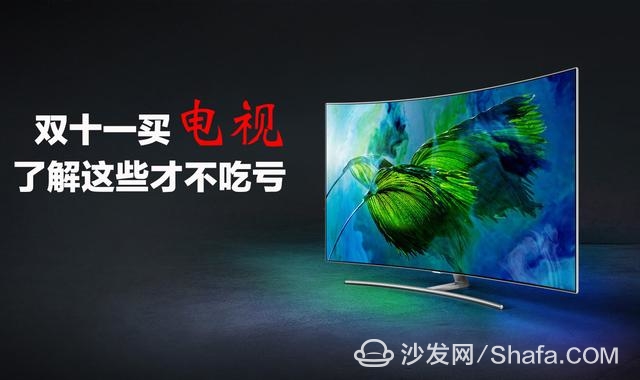
Speaking of the television industry, the recent television manufacturers have not been idle. They have launched new products and various promotional activities. The price is also lower than that of a single family. They hope to seize the share in the sales season in the double 11 and the end of the year. Xiao Bian searched a bit, all manufacturers took a variety of models to participate in the double 11 promotional activities, and these models without exception will advertise that they are high-profile, high-quality, so that you have to buy is to earn Both sense. So, what model is worth buying this year?
Taking advantage of the fact that everyone is not even on the double eleventh, Xiaobian plans to use a variety of televisions to compare the actual situation. I hope that my friends will know where the differences in these TVs are, especially some ultra-low-cost TVs. Which "Kung Fu" to save money. I hope that through this article, you will be able to clearly understand the white goods and not waste every penny.
Frankly speaking, there are quite a few articles on television on the Internet, and even some "professional" media in the TV industry are basically simply listing the various slogans. The final conclusion of the article is "Which is more? Well, please choose according to your needs and preferences." Personally, this kind of meaningless article will make readers confused.
In order to make the double 11 purchase more cost-effective, Xiao Bian chose several brands such as Xiaomi, Leshi, Sharp, Skyworth, and Hisense, with sizes of 40/43 inch, 49/50 inch, 55 inch, and 65 inch. The models are compared. I hope that you can understand how the 11th choice of TV can not be "routine".
Compare brands and models:
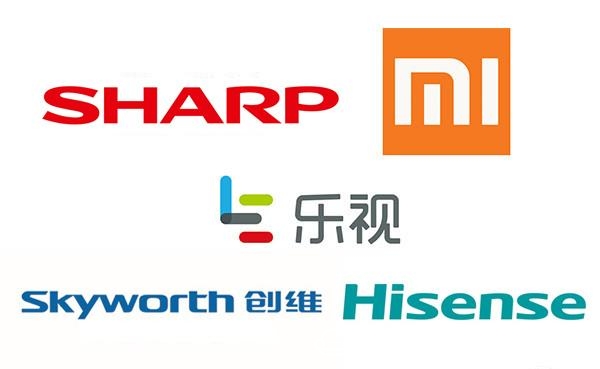
Comparison brand
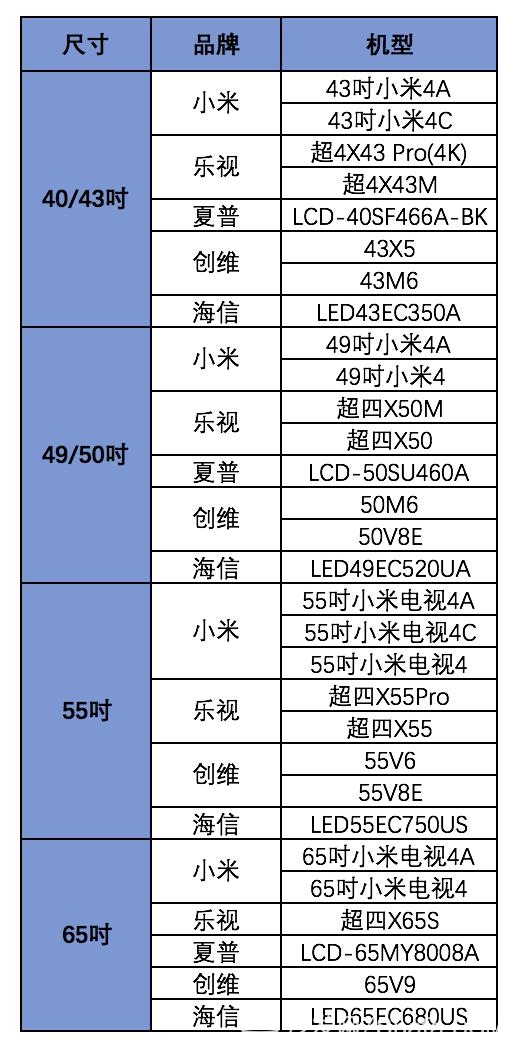
Comparison models
1. Quality: Preferences for Buying TV
Simply talking about picture quality is the quality of the picture. Picture quality is a very important feature of a television and directly relates to the viewing experience. The influencing factors of image quality include screen and backlight specifications, chip image quality processing, and image quality adjustment.
When selecting TVs, we all want to buy better quality products. Some friends believe in "seeing is believing," they will go to the offline store to compare prices before ordering, but in reality many TV manufacturers will specifically adjust the store prototype to a "shopping mall display mode," and the source of the broadcast is also All have been specially selected, making it difficult for you to see obvious quality issues. Moreover, the double eleven more people are placing orders directly on the Internet and they have not seen the actual machine before arriving. Is there a simple way to determine the quality rating of a TV? According to Xiao Bian's following points, you will not be dazzled.
1. Screen: Is it necessary to care about LCD panel manufacturers and "soft and hard screens"?

Buying a TV is to buy a screen?
As a display device, the importance of the screen is self-evident. From the perspective of cost structure, the cost of the screen accounts for more than 60% of the total cost of the TV. Therefore, “buy TV is to buy the screen†is the inherent concept of many people. Because of this, some of the important promotional points for low-cost models are the “Korea/Japan original panelâ€, which gives consumers the impression that “Don’t look at my low price, but I use imported original panels, so I’m cost-effectiveâ€. Are the panels of different manufacturers different in quality? Imported panel prices will be very expensive?
In fact, LCD technology has developed very well in recent years. The screen manufacturers, whether it is the panel makers in Korea, Japan, Taiwan or the mainland, have very little differences in the quality and product quality of their LCD panels. Moreover, for panels of the same size, the prices of all manufacturers are almost identical.

LCD panel price list (October 2017)
The table above shows the price data published by Quzhi Consulting, an authoritative research company in the industry. Xiaobian uses only 32", 43", and 55" as examples. It can be seen that the price difference between screen manufacturers is very different. The difference of 1-2 US dollars between different screen factories is only related to the relationship between supply and demand at that time, and has nothing to do with quality or quality.
I believe there will be doubts about seeing friends here. Since the price of "imported original panels" is the same as the price of "domestic panels," why aren't all large TV manufacturers using the "imperative" better imported panels? In fact, TV manufacturers choose the panel basically has no specific brand preference, only related to the status of each supply chain. On the one hand, for the big TV manufacturers, due to the huge volume of shipments, to ensure the stability of supply, the same model will also purchase several panels of mixed shipments. On the other hand, some television brands themselves have their own panel factories. For example, TCL is the parent company of China Star Optoelectronics. Naturally, it prefers its own panel resources.

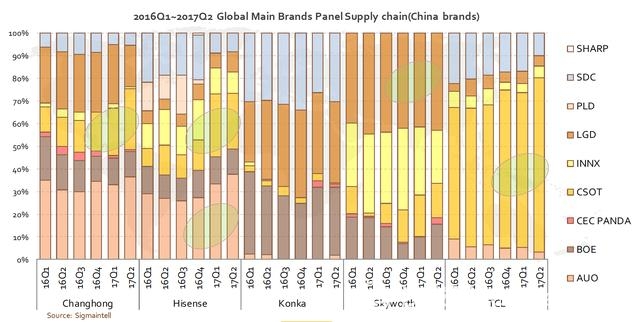
The above two figures are the panel brand structure used by various TV manufacturers. It can be seen from the data that internationally renowned brands such as SONY and Samsung have been using panels such as BOE, China Star Optronics, Innolux, and Taiwan Screen Factory. The picture quality of these branded TV sets is a consensus of many people. It can also be seen that the picture quality is not directly related to the brand of the panel.
Therefore, it is no matter which manufacturer's panel is used to buy TV at the moment. There is no clear distinction between the quality of each panel.

Some users choose to care about whether the screen is "soft screen" or "hard screen". This so-called "soft and hard screen" is just a popular saying, and it has nothing to do with the physical hardness of the screen. The difference between the soft screen and the hard screen is that the liquid crystal molecules in the panel are arranged differently, and thus the picture quality will have slight differences. For example, the soft screen has a better contrast ratio (4000-6000:1), but the viewing angle is more general; the hard screen's viewing angle and color have advantages, but the contrast is worse (1000-1400:1). Soft screens and hard screens have their own advantages and disadvantages, but the difference in the quality of the normal viewing is not great. You do not need to pay attention to whether the TV is a soft screen or a hard screen.

Differences in the arrangement of liquid crystal molecules lead to differences in the touch of the hard and soft screens, but the difference in image quality during normal viewing is not significant.
2. Screen gamut: Low-end and low-cost TVs do not basically do high gamut (wide color gamut)
The color gamut of a television is simply the range of the color of the television. If the TV is not a high-gamut screen, the TV screen will not be able to accurately reproduce the bright colors of dark red, dark green, and dark blue in the screen, and alternative displays can only be made with lighter colors. TVs with a high color gamut can accurately display various colors and bring more realistic picture performance.

High color television can bring better color performance
Seeing here, I believe there will be a friend who said: "My family's television is not a high color gamut. I didn't think it was a good picture for many years." In fact, the reason is very simple, the quality of the technology is constantly improving, good quality needs to be compared, when your eyes have become accustomed to the general color gamut, they will think that the color of the television should be like this. But when you see a more vivid and vivid color gamut, see brighter safflowers, more wilting willows, and deeper clear blue skies, your eyes will never return. It's like the screen resolution of the mobile phone we used was very low, and it didn't seem to be a bad idea to use it all the time, but when you use a more delicate retina screen, you can no longer tolerate the rough, low-resolution screen. The high color gamut of television is also a reason.
Technical means used by the television industry to achieve high color gamut include high color gamut liquid crystal panel color filter film (CF) technology, high color gamut LED phosphor technology, and quantum dot backlight technology. Each of these technologies has its own advantages and disadvantages. But no matter what kind of technology, you can achieve better color performance than conventional gamut TV. Of course, no matter what kind of high color gamut technology, you need to increase the cost of the TV, which is why the low-cost TVs on the market do not use the high color gamut screen design.
Back to the specific model, the color gamut of these contrasting machines is as follows:
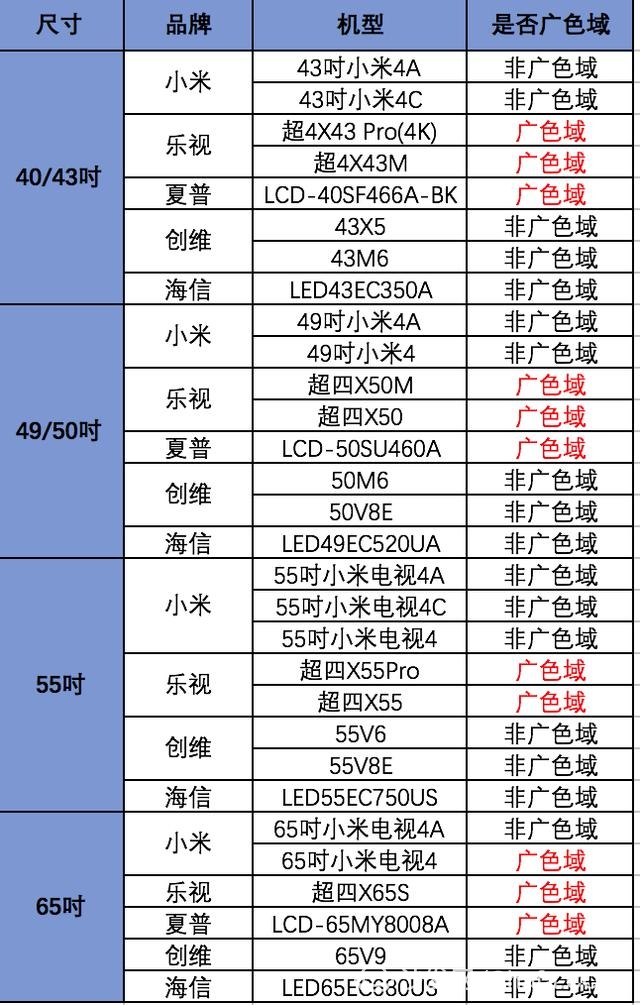
LeTV and Sharp adopt a wide color gamut design (above information from the product website)
Select the TV, Xiaobian suggest that you prefer the high color gamut.
3. Motion Picture Compensation (MEMC): Seeing large movies and ball games can greatly improve the picture quality
The so-called MEMC, the full name is Motion Estimate and Motion Compensation, that is, motion estimation and motion compensation technology. When playing dynamic video, the MEMC chip will perform frame interpolation processing on adjacent pictures. When watching fast-moving images such as ball games, racing cars, and motion pictures, MEMC can significantly improve the smoothness of the picture and eliminate the sensation of rattling.
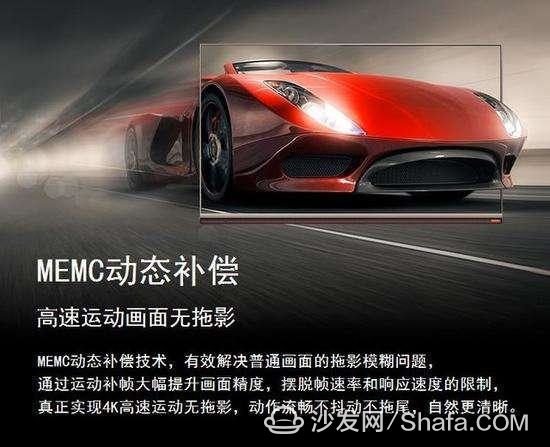
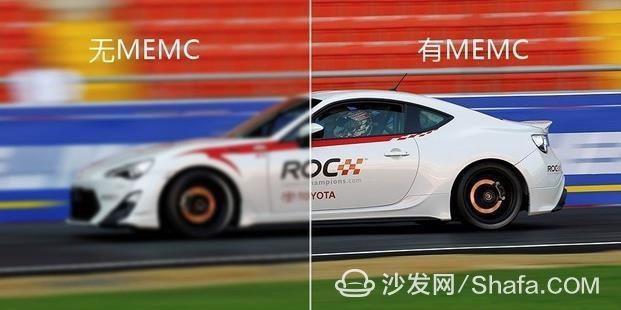
Since the MEMC function requires a high chip processing capability, the MEMC function was generally completed in a separate chip in previous years. With the improvement of chip processing capabilities in recent years, MEMC has been integrated into the main chip of some high-end televisions. Such as Mstar's 6A938 chip, built-in MEMC function. Of course, the price of high-end chips is naturally not cheap.
Select TV. It is recommended that you prefer the model with MEMC. Currently, most of the medium and low-priced models on the market will not be equipped with MEMC functions. Controlling costs is the most important reason.
Contrast model MEMC function is equipped with:

Each model MEMC function comparison
According to the above table, LeTV's full range of models have MEMC capabilities. This is because LeSco has adopted the Mstar 6A938, which is currently the strongest chip in the TV industry.
two. Is the hardware configuration of the TV important?
The TV hardware configuration mentioned here refers to the main chip, memory, and flash memory specifications of the TV. There may be some friends that: my home TV is mainly to look at online video and television programs, do not need very high-end hardware configuration. In fact, according to Xiao Bian, this argument is open to question.
In terms of chip specifications, higher-level chip configurations not only allow faster TV operation, smoother operation, and better video decoding capability, but also feature higher-grade TV chips with a higher-level image processing engine. There are also differences in picture quality and functionality between low-end machines.

Mass production of ARM CPU platform ladder (currently the highest level of smart TV chip is A72 and A73 architecture)
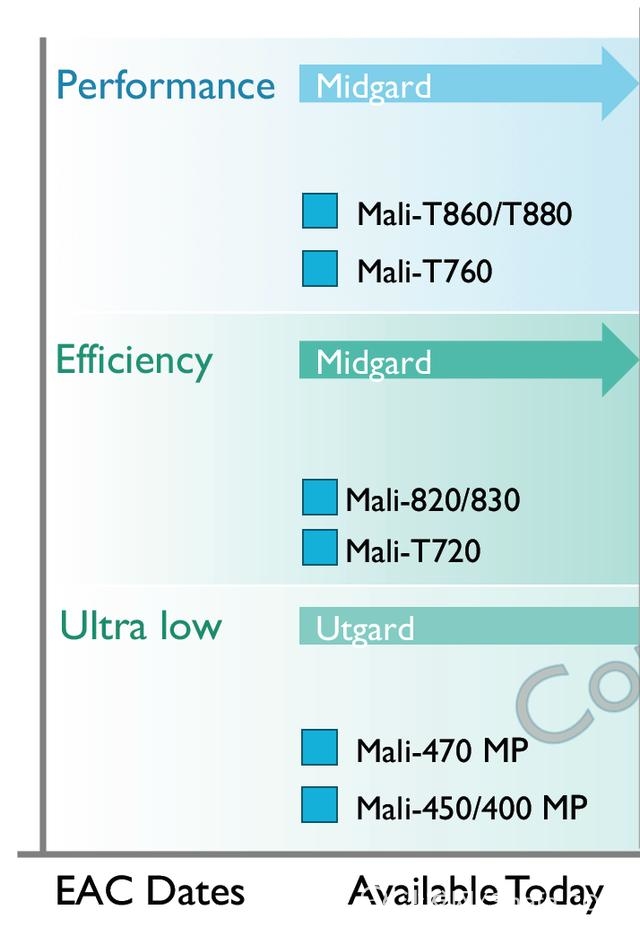
ARM GPU platform ladder (currently the highest level of smart TV chip is Mal-820 and 830)
In terms of the importance of memory capacity, smart TVs are now dominated by Android systems. Version upgrades and iterations of Android systems and third-party software upgrades will increase the demand for memory capacity and fragmentation of Android systems. "Characteristics will also make the system "more and more cards." TV makers have simplified and optimized the Android system so that some small-memory TVs are still running smoothly. There is no problem at the moment. But in the long term, these small memory TVs may not be able to upgrade to the latest version of the system, run and install later updated applications (such as third party video applications, big screen games, etc. ) will surely get more and more stuck.
In the past more than a year, the price of memory has continued to soar, and it has become increasingly fierce. Under this background, the memory capacity naturally becomes one of the important factors that affect the cost of the TV. At present, most models on the market have a memory capacity of 2GB or less, and even TVs with 512MB of memory are sold. To tell the truth, Xiao Bian can hardly imagine what the 512 MB RAM Android TV will look like after a while.

In order to ensure the long-term fluency of televisions, we must pay attention to and compare the specifications of the chips and memory when selecting TVs.
Comparison models are as follows:
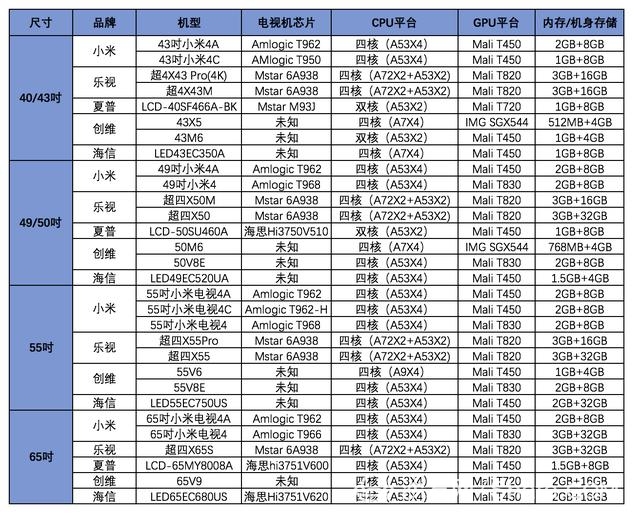
Comparison model hardware configuration comparison

three. Is it necessary to choose "artificial intelligence TV" for TV election?
To say that this year's science and technology circle is the most popular concept word, non-"artificial intelligence" is none other than. After some TV manufacturers were unwilling, they launched "artificial smart TVs" and promoted them as major selling points. An e-commerce platform also called for the establishment of the "Artificial and Smart TV Industry Alliance," and also released the "Artificial Intelligence Television White Paper."
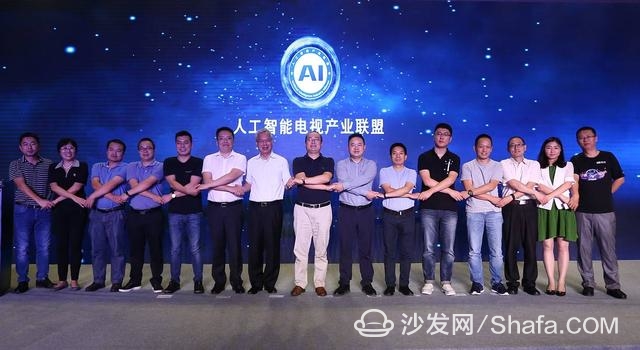
Founded in August this year, "Artificial and Intelligent Television Industry Alliance"
However, if we carefully analyze the so-called "artificial intelligence TV" on the market, we only have the following functions: 1. Voice control function, through video search source, control playback, etc.; 2. Cloud analysis user's habits and preferences for intelligent recommendations .
Regarding the voice control function, I do not know whether there are friends remembering the first Android smart TV K91 launched by Lenovo in 2012. Although Lenovo’s TV business has been tepid, the world’s first TV with Android installed has caused a lot of repercussions in the industry. This 5 years old TV already supports voice input, search source and voice control.
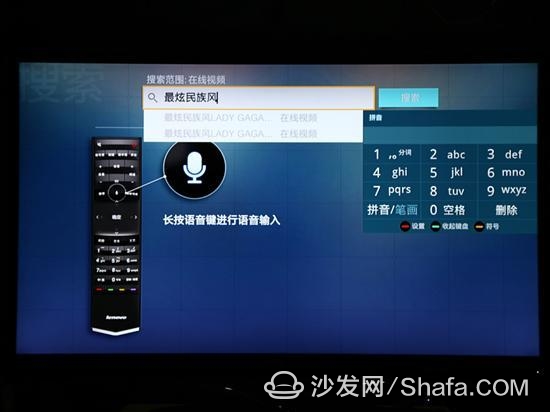
The K91 smart TV released by Lenovo in 2012 already has voice control function
Now more than five years have passed, it is undeniable that voice recognition technology has made great progress, voice control has long been a standard feature of many smart TVs. As for the smart film source recommendation, this is not what new concepts and technologies. In essence, today's "artificial intelligence television" is actually just a new concept of the old function.
So, why did TV manufacturers launch "artificial intelligence TVs?" In Xiaobian's opinion this year, there are two main factors: On the one hand, the lack of new technology in the TV industry. The technological innovation points of the television industry in previous years include 4K/8K, HDR, quantum dots, and OLED. However, almost no new technical points have appeared in the past 1-2 years. In order to increase the selling point of new products, TV manufacturers have put the current hottest technology concept "artificial intelligence" into account. (If you pay attention, more than a year ago, when VR concepts were hot, many manufacturers launched "VR TVs." "The use experience is very poor, needless to say, and ultimately it all came to no end.) On the other hand, with the soaring prices of LCD panels in the past year (the price has dropped in the second half of this year), all manufacturers are considering to pursue profitability and market competition. They have made great efforts to reduce costs. If you compare carefully, you will find that the so-called “new TVs†released by many manufacturers this year have significantly reduced the hardware configuration and specifications of previous products. However, these low-end, low-cost machines with reduced costs do not have outstanding “hard selling points†in terms of picture quality, sound quality, etc., and are advertised using “artificial intelligenceâ€, a software function that hardly increases cost.
The "artificial intelligence TV" at this stage is far from the real "artificial intelligence". When we select TVs, it is totally unnecessary to entangle whether the TV is a so-called "artificial intelligence TV."
four. The models vary greatly in materials and designs
Many consumers only pay attention to the two factors of "size" and "price" when choosing a TV. They think that "XXXX as long as XXXX" is cost-effective. Some manufacturers have grasped the psychology of this part of the user, trying to reduce the price by reducing costs. According to Xiao Bian, this model is only a low-end machine with a low price, and its price/performance ratio is not high.
Xiao Bian here quotes several TV manufacturers to reduce the cost of materials, we can take the comparative prototype of this article to the seat:
1. Is the front frame of the body made of plastic or metal? If the metal frame is made of iron or aluminum, what is the processing technology?
2. Is the material of the base metal, plastic iron, or plastic?
3. Is the plastic back shell made of PC+ABS or HIPS? (PC+ABS: good glossiness, good thermal deformation and flame retardancy, high comprehensive performance, but high cost; HIPS: poor surface gloss, flame retardancy such as PC+ABS, poor thermal deformation, and low price)
4. Is the screen backlight design E-LED (side-in) or D-LED (direct-down)? (Side-in type: thin screen, beautiful appearance, but high cost; direct type: the thickness of the screen is very thick, the cost of the backlight can be very low. Some of these prototypes are direct-lit backlights, but only the edge of the screen is advertised. Thin thickness)
The above Xiao Bian just gave a few examples, these are directly related to the cost of the TV. The difference in materials used not only affects the appearance of the appearance, but also has a certain impact on the safety, reliability and service life of the TV.
There must be cheap reason for the cheaper. When you buy a TV, don't just look at the "size" and "price". If you compare them carefully, you won't lose.
Summary of parameters:
Xiao Bian put together the specifications of the models mentioned in the previous paragraph, and attached the promotional price of each model of the Double 11 for your reference (Prices from Jingdong, Tmall and various brands' official websites, double 11 During the period of the various promotional policies may be updated at any time, the specific price at the current price shall prevail:

Consolidation of various models of parameters
In fact, the purpose of writing this article is not to want to guide you to buy which specific models. Just want to pass through the comparison of these models, so that you understand where some TV manufacturers' "routines" are. In particular, some of the ultra-low-cost TVs are the real reason why they are cheap. Believe in the contents of this article, those TV manufacturers' promotional texts will not tell you.
No matter if it is a low-end TV or a top model, each TV has its own target customer base. If your budget for buying TV is limited, the demand for picture quality, hardware configuration, TV appearance and product quality is not high, as long as it is basically enough, some ultra-low-cost brand TVs can be considered, after all, all models The price difference is not a small number for some people; however, if you want to buy a TV with excellent picture quality, high-end configuration, and smooth use, it is important not to use price as the only selection criterion. After all, TVs and cell phones are different. Many people will change their cell phones one year or even six months. TVs are generally kept at home for four to five years.
In short, Xiao Bian hopes that your purchasing behavior will be based on a full understanding of his own needs and the actual condition of the TV set, instead of relying solely on the promotion and guidance of TV manufacturers. Not white flowers. I wish you a good TV with double 11 to buy for you!
Smart TV/box information can focus on smart TV information network sofa butler (http://), China's influential TV box and smart TV website, providing information, communication, TV boxes, smart TVs, smart TV software, etc. Answering questions.NTC Thermistor
Feyvan electronics offers a wide selection of high quality NTC thermistors. All thermistor material and chips are made in Jiangsu, China.
NTC thermistors and sensors are everywhere in our daily life and will have a wider range of uses in the future which have been used in automotive, household appliances, computers, medical equipment, electronic thermometer, digital thermostats, portable heaters, printer, air conditioners and refrigerators...
Our negative temperature coefficient thermistor with the characteristics of small size, fast response, high-accuracy, high stability and reliability divides into glass-encapsulated series, power series, epoxy coated series, film temperature measurement series and temperature measurement series.
Ntc Thermistor,Ntc Probe,Ntc Resistor,Thermistor Sensor
Feyvan Electronics Technology Co., Ltd. , https://www.fv-cable-assembly.com